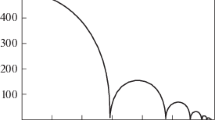Abstract
Depressurization of high-pressure vessels filled with a liquid coming to the boil with a decrease in pressure is investigated. After depressurization, which takes less than 1 ms, a rarefaction wave propagates into the vessel. Experiments [1–5] demonstrated that the pressure behind the wave goes over to a constant value, which is independent of the vessel diameter and lies between the saturation point and atmospheric pressure.
The correspondence between the experiments and different bubble formation theories (bubble formation on the vessel walls, due to rupture of the bonds between the water molecules or boiling on foreign particles) is analyzed. A “ mechanical nucleation” theory is proposed, in which it is assumed that the liquid comes to the boil on a limited number of foreign particles, and the bubbles formed on the nucleation centers undergo multiple fragmentation due to the instability developing under the action of centrifugal accelerations of the bubble surface in the course of bubble growth.
The calculations demonstrated that, after depressurization, bubble fragmentation occurs at the vessel outlet. Due to the growth of the phase interface in the course of fragmentation, the boiling intensity increases, the pressure grows, and a shock wave propagates into the vessel, following the rarefaction wave. Multiple fragmentation of the bubbles occurs on the shock front. This wave is followed by a series of waves with smaller amplitudes. The pressure in the vessel attains a stable level, without any shocks. This level is characterized by the metastability or superheating of the liquid, i.e. the difference between the liquid temperature and the saturation point. It is demonstrated that the resultant pressure in the vessel is independent of the number of initial boiling centers or the initial pressure in the vessel and is determined only by the initial temperature. For water, the dependence of the superheating of the liquid on the initial temperature is found and compared with experimental data.
Similar content being viewed by others
REFERENCES
A. R. Edwards and T. P. O’Brien,“Studies on phenomena connected with the depressurization of water reactors,” J. Brit. Nucl. Engng. Soc. 9, No.2, 125–135 (1970).
J. H. Lienhard, M. Alamgir, and M. Trela,“Early response of hot water to sudden release from high pressure,” Trans. ASME, Heat Transfer, 100, No.3, 473–479 (1978).
O. A. Isaev, Liquid Boiling under a Rapid Pressure Drop in Adiabatic Unsteady Flow [in Russian], Autoref. Diss. Kand. Fiz. Mat. Nauk, Ural Polytechnic Institute, Sverdlovsk (1980).
W. S. Winters, Jr., and H. Merte, Jr., “Experimental and nonequilibrium analysis of pipe blowdowns,” Nucl. Sci. Engng., 69, No.3, 411–429 (1979).
N. G. Rassokhin, et al. “Critical conditions in unsteady two-phase flow in pipe blowdown,” Teplofiz. Vys. Temp., 15, No.3, 589–597 (1977).
R. I. Nigmatulin, Dynamics of Multiphase Media. V.1, V.2, Hemisphere, Washington (1989).
Y. Hanaoka, I. Tokura, and H. Tonino, “On incipience of bubble formation in depressurization process under micro-gravity environment,” In: Proc. Workshop on Short-Term Experiments under Strongly reduced Gravity-Drop Tower Days 1998 in Hakkaido (1998), pp. 98–101.
J. E. Shepherd and B. Sturtevant, “Rapid evaporation at a superheat limit,” J. Fluid Mech., 121, 379–402 (1982).
V. P. Skripov, Metastable Liquid [in Russian], Nauka, Moscow (1972).
O. E. Ivashnev, M. N. Ivashneva, and N. N. Smirnov, “Rarefaction waves in nonequilibrium-boiling fluid flows,” Fluid Dynamics, 35, No.4, 485–495 (2000).
L. E. Scriven, “On the dynamics of phase growth,” Chem. Eng. Sci., 10, No.1–2, 1–13 (1959).
D. A. Labuntsov, et al., “Investigation, using high-speed filming, of bubble growth in boiling of saturated water on a wide range of pressure variation,” Teplofiz. Vys. Temp., 2, No.3, 446–453 (1964).
G. Birkhoff, Hydrodynamics, Princeton (1950).
Additional information
__________
Translated from Izvestiya Rossiiskoi Academii Nauk, Mekhanika Zhidkosti i Gaza, No. 3, 2005, pp. 103–117.
Original Russian Text Copyright © 2005 by Ivashnev and Smirnov.
Rights and permissions
About this article
Cite this article
Ivashnev, O.E., Smirnov, N.N. Appearance of Nucleation Shocks in a Boiling Liquid. Fluid Dyn 40, 426–438 (2005). https://doi.org/10.1007/s10697-005-0082-8
Received:
Issue Date:
DOI: https://doi.org/10.1007/s10697-005-0082-8




